Understanding how to read a German Shepherd’s body language is crucial in fostering a strong bond between an owner and their dog. While we may not be able to engage in verbal dialogues with our German Shepherds, there’s an ongoing, silent conversation happening through their body language.
To read a German Shepherd’s body language, observe their actions, such as when they avert their gaze, lick their lips, or tuck their tail, as these can provide invaluable insights into their feelings and needs.
Learning to interpret these signals is key to responding appropriately and strengthening your relationship.
Throughout this article, you’ll learn about the German Shepherd’s body language and how to communicate with your dog.
Let’s get started!
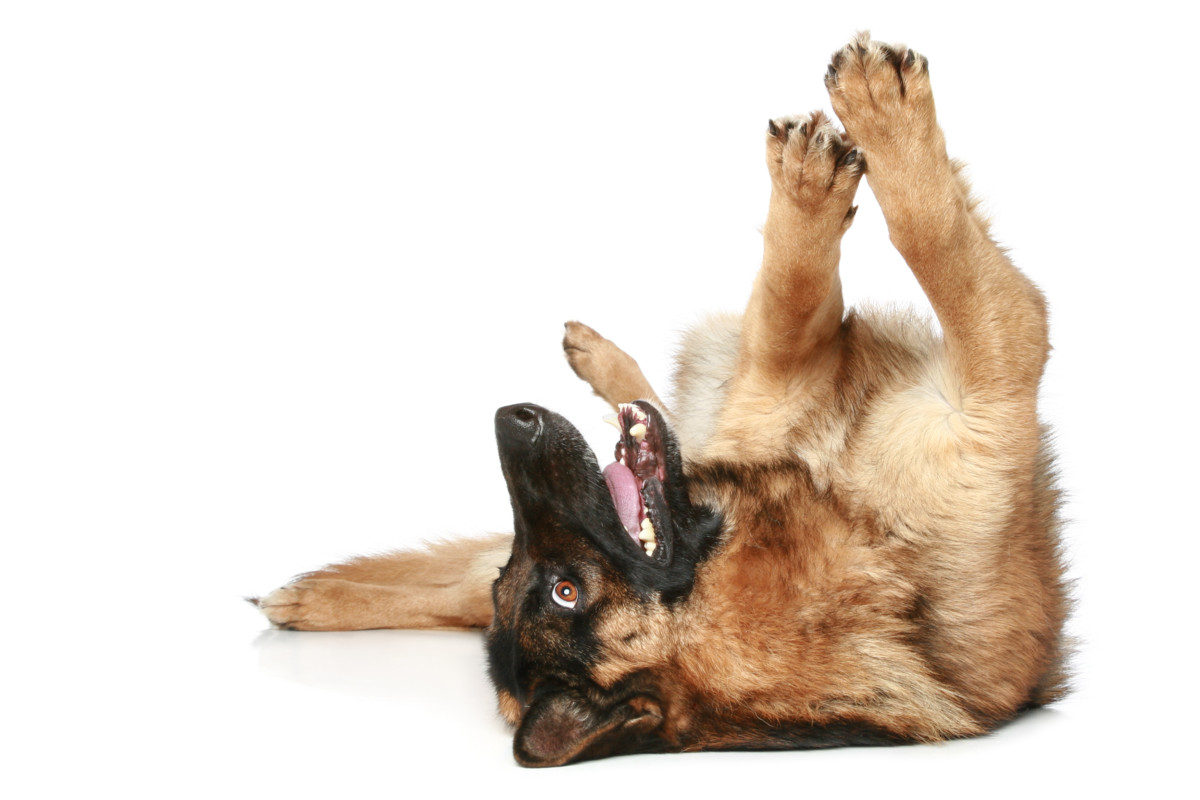
Reading Your German Shepherd’s Gestures
Without any way of communicating with you verbally (other than barking), your German Shepherd has to use body language to get his point across.
You will get to know all of the body language that your GSD displays – but it’s also important to understand how unfamiliar dogs communicate.
Let’s look at 15 ways dogs might try to tell you something. Here’s a quick glimpse listing all these signs.
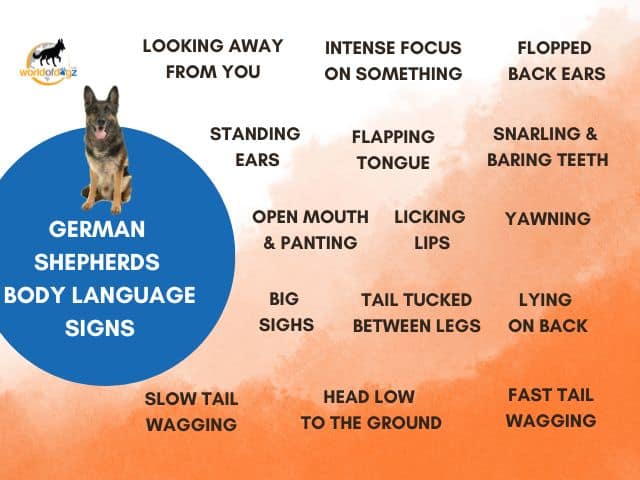
- Looking away from you is a common sign of submissiveness. When trying to read your German Shepherd’s body language and he doesn’t look at you directly in the eyes for too long, he’s letting you know that you’re the one in charge. It’s not a sign of fear but respect and acknowledging the hierarchy between you.
- Intense focus and staring at one object, person, or animal is a potential sign of aggression. While it sometimes means that your German Shepherd is confused about what’s happening, it’s often an indicator that he will bark or, even worse, bite. Check to see if his hair is standing up or not. If it is, move away slowly. For more detail on this, here are some reasons why your German Shepherd’s hackles stand up.
- Flopped back ears are a good sign. This means that your German Shepherd is relaxed, calm, and in a friendly mood. If you notice that the ears flop back, you’ve created an environment that makes him feel comfortable. Try to maintain the atmosphere and avoid sudden loud noises that might startle your dog. To learn more about ear positions, check out this article, German Shepherds Ears Meaning.
- Standing ears can mean a few different things. First, it could simply mean that your German Shepherd is interested or curious about what they’re hearing. Your GSD could be excited during periods of play. It could also mean they’re alert, nervous, or frightened of a sudden sound or an approaching threat. The best way to determine the cause is to look at his other body language and the surrounding environment.
- Open mouth and panting are a combination that means your dog is either tired from exercise or is stressed. If your dog won’t stop panting, it’s likely due to something they’re afraid of or not used to. Separation anxiety or the presence of a new visitor could be the cause as well.
- Snarling and baring teeth are both signs of aggression. This is one of the easiest types of body language to read in your German Shepherd. GSDs are strong and fast, so you must stop doing whatever irritates them! Although you might need to establish dominance, now isn’t the time. Once he’s calmed down, you can start the process. You can do this by distracting him with his favorite toys and using a calm and confident tone.
- Yawning can mean a few different things as well. It could simply mean that your GSD is tired and needs some rest, but it could also indicate that they’re stressed. Yawning is often a sign of submissiveness or worry that something will harm them. If your dog keeps yawning, figure out what’s causing the stress.
- Licking their lips and flapping their tongue could mean your dog wants to be left alone. If your dog turns away from you while performing these actions, they’re probably trying to tell you that they don’t want to be held, petted, or touched. It’s not a case of being offended but respecting their wishes.
- Big sighs are often accompanied by stretching, but they’re usually just a sigh of relief. It’s a bit comical, but your German Shepherd might let out a sigh when all of your guests leave! They finally feel they can relax and not stress out about dealing with outsiders. It could also just mean they’re calm with everything around them.
- Slow tail wagging either means that your dog is content and being playful – or it could mean that they’re a bit worried about something they heard or saw. A slow wag is less social than other types of tail-wagging communication, and if the tail is neither high nor low, it usually means a sign of insecurity. The tail in this position can quickly adapt depending on the situation. If you’re talking to your GSD or are out walking him, he might slowly wag his tail unintentionally. It’s basically identical to a light smile on a human’s face.
- Fast tail wagging means that they’re having an incredibly good time, but it could also mean that they’re worried. If you’re playing with your German Shepherd, this body language is usually the former. However, if he meets a new person or your dog sees another dog walk by, he might be nervous. Nervousness is usually accompanied by a stiff, straight tail, though.
- When their tail is tucked between their legs, it’s a sign of fear. When reading this body language in your German Shepherd, it could also be accompanied by shaking, panting, and drooling. Your German Shepherd is unsure about something, and it’s making him feel very uncomfortable. If it is a sound or something else that’s harmless, try to calm him down by using gentle tones, playing, or relaxing with him.
- Tail positioning is very important, as well. If his tail is high, it usually means your GSD is very excited or showing signs of dominance. It could be a sign of them challenging another animal. A low-hanging tail means that he is relaxed, and a tail that remains at the halfway position means that he hasn’t quite committed to his response yet. All of this can get pretty confusing, so I wrote an entire article on the meaning of German Shepherds’ tail positions, or you can watch the video below:
- If your German Shepherd is lying on his back and resting, it means that he trusts you. Dogs love to sleep on their back, but they usually won’t do it unless they trust their surroundings since they’re vulnerable. You should be proud and happy if your GSD is sleeping or resting this way, as they are submissive and acknowledging that you are the boss!
- When your dog has his head low to the ground and his back end high, he’s playful. This is known as the play bow. When your German Shepherd displays this body language, it’s fun to actually mimic the same behavior to let your dog know that you’re ready to play with him. Even if he’s lying down, this motion will get him excited.
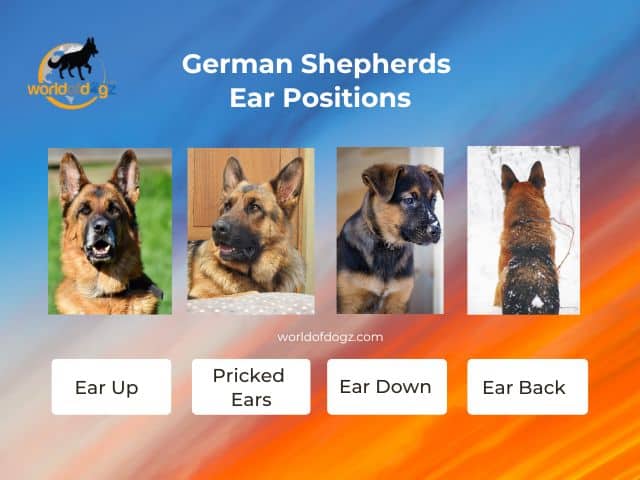
Nervous Body Language
German Shepherds wear their emotions on their sleeves. They’re not known for shying away from showing people how they feel, as they are very affectionate and social dogs.
If your dog is excited, you’ll know from his running, tail wagging, and ear position. If he’s nervous, he might have his tail tucked or ears pinned back.
One reason that your dog might be displaying nervous body language is that they’re worried about you! If you leave him alone too much, he can develop separation anxiety.
Sadly, many German Shepherds suffer from this type of stress due to the intense bond they form with their owners. When you leave, he’s worried that you’ll never come back.
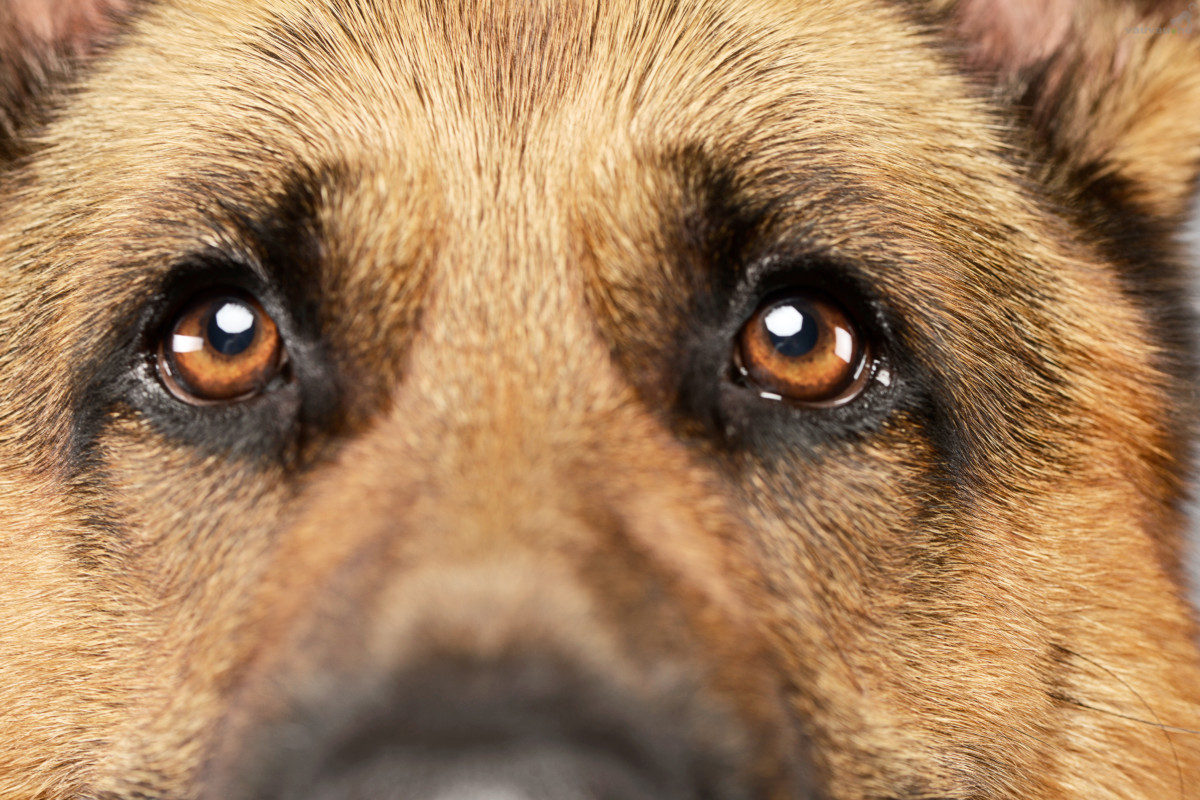
Another explanation is that your GSD has heard something outside or around them that causes concern.
Many dogs get frightened by loud noises such as fireworks, motorbikes, and thunder. You and I are used to the sounds because we know what they are, but German Shepherds aren’t at all expecting such an abrupt and unknown noise.
Depression causes nervousness in GSDs, which could be a cause of their body language. If your dog is always panting or pacing, he’s probably worried about something.
For example, if you’re always stressed or anxious, he will use your body signs to determine if something’s wrong.
This study by Animal Cognition even found that dogs can use their sense of smell to understand their owner’s emotions and mood.
Some health conditions can cause nervousness. Here’s a handful of issues to be aware of:
- High blood pressure
- Elevated heart rate
- Food or other allergies
- Digestive issues and a sensitive stomach
- Muscle and joint pain
- Hip or elbow dysplasia
All of these problems can be concerning – but try not to worry. Whatever the cause, never let it sit for too long without giving it attention and seeking help and advice from your veterinarian.
Communicating With Your German Shepherd
Are you having trouble trying to communicate with your German Shepherd and read his body language?
There have been countless attempts to bridge the communication gap between humanity and their dogs, but none have worked outside of tone and body language. Some people have even gone as far as training their GSD to listen to German commands!
Check out this awesome short video from Zak George showing you how to communicate with your dog by using a quiet and sincere tone and lots of eye contact. I’m a big fan of Zak and love his ethical training methods:
Fortunately, dogs can read your body language just as you can read theirs. German Shepherds are highly intelligent and can understand your intent if you express how you feel through physical motions, but they also hear the volume and tone of your voice.
When you yell, they know you’re mad. If you speak in an excited voice, they will be happy. For more info on the correct way to discipline your dog, check out this article, Disciplining a German Shepherd the Right Way.
The best way to communicate with your German Shepherd is to use hand motions and copy what he tends to do.
If you want to play with him, wave his favorite toy and increase the pitch of your voice. If you want him to back away from something, use a firm tone and point at or away from it.
Communication is essential when you’re trying to develop a relationship with your German Shepherd. Males can become dominant and possessive, so it’s important to put your foot down and be firm with them whilst young.
Females are much more submissive and will likely try to please you rather than go about their own activities.
Remember that your dog can’t understand your language. They might know their name or a few commands, but they’ll never be able to comprehend sentences.
Scolding them by talking down to them in a demeaning tone will only make him feel sad and confused as he won’t know what he did wrong. Always gesticulate to let him know what you mean.
Finally, be persistent. Think about how hard it is for you to learn a new language. It can take weeks or months to form a proper sentence!
The same rules apply when teaching your dog how to communicate with you and vice versa. Patience and consistency are key components in the relationship, so keep at it, and you’ll enjoy the results.
Let’s now look at a couple of examples of German Shepherd body language and how to read what your dog is trying to tell you.
Why Does My German Shepherd Always Lay on My Head?
It’s no secret that German Shepherds are large breed dogs. However, that doesn’t stop them from trying to cuddle with you as if they were ten times smaller than they actually are! They want to build on their bond with you, and they feel comfortable and relaxed in your presence.
If you let your German Shepherd sleep with you, it might be a nuisance for him to lay on your head every night, but they do it for a few reasons.
Here are three reasons why your German Shepherd lays on your head:
- He wants to be near you, and he knows that your head is where all of your expressions and vocal tones come from. Dogs feel closest to you when they’re near your head. Think about how they jump to your face when they want to lick you or play and how they look into your eyes when they want attention.
- If your head is warm, your German Shepherd is likely laying on it to keep himself comfortable. Our heads, hands, and feet are where the heat goes in and out of our bodies the most. It might be a bit selfish, but it’s also adorable to know that you’re the source of his relaxation.
- He may be afraid of something. If he’s always anxious or fearful, he will run to you, his protector. Your dog might not have an immediate fear of something around the house, but constant anxiety can make him lie on your head to calm down. Once again, you’re the source of his feeling relaxed and calm.
It might seem like a weird thing, but German Shepherds are head layers more often than you’d think. Even if your bed is small, he’ll find a way to get as close to you as possible.
If you don’t like the habit, you should insist on keeping him off the bed altogether, as sectioning off a small portion is hard for them to understand.
Why is My German Shepherd Always Lying Down?
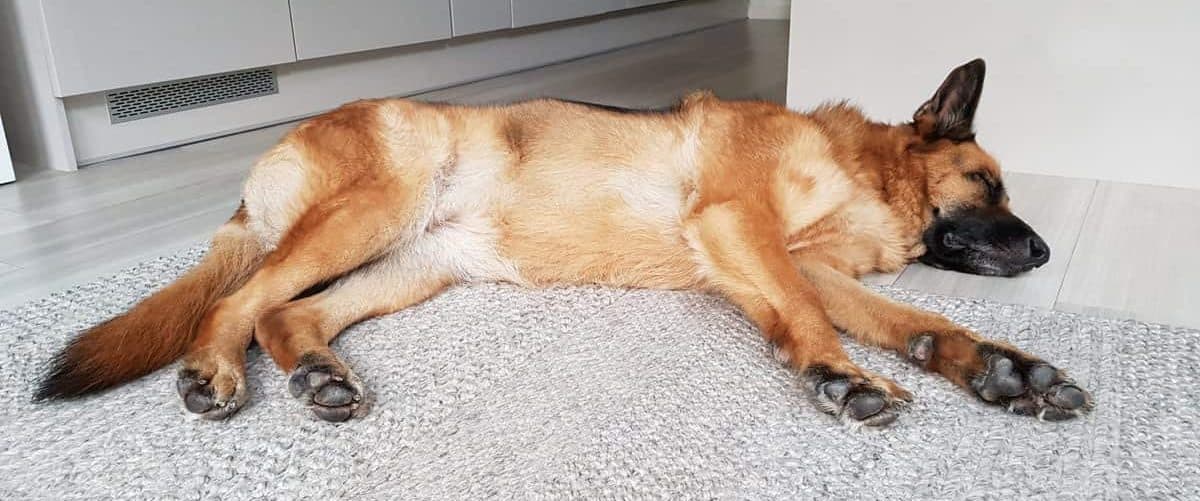
German Shepherds, like all other dog breeds, can have lazy days. If they’re lying around all day, it’s no cause for concern. That being said, you might be a bit worried if they start to lie and hide away from you for more than a day.
Don’t fret just yet, though. There are plenty of reasons that this could occur.
Let’s examine a list of possibilities below:
- He might just be tired, mainly if he has exerted himself with a ton of exercise, such as a long hike or hours of frisbee. When the weather starts to change and clouds roll in, we all get dreary and tired earlier. There’s no need to worry, though, especially if he has done this in previous years. You can go about your day with your GSD as usual if he doesn’t have Canine Seasonal Affective Disorder.
- On the other hand, it could be a sign of depression. German Shepherds might get depressed if their needs aren’t being met. Whether it’s from lack of nutrition, not enough interaction with you, insufficient exercise, or a chemical imbalance, they’re no different than humans. Remember, German Shepherds need lots of mental stimulation and play, not just a walk on the leash! Ask your vet if you notice signs of depression.
- He might be exhausted from playing all the time. If your GSD is constantly running in and out of the house throughout the day, he’ll probably lie down a lot to regain his energy. Again, there’s no need to worry; He’s just having a blast and relaxing in between bouts!
- If your GSD is a puppy, then you should expect him to lie down quite often. Tiredness is a common symptom with puppies of all dog breeds. There’s nothing wrong with it at all. In fact, sleeping is essential for healthy growth. Do your best to let them stay asleep as long as they can, as puppies can sleep up to 18 hours per day!
- Your German Shepherd might be looking for attention. Not all dogs have the courage to seek your approval continuously. An excellent way to notice if he is doing this is to watch his eyes. If your dog’s eyes are darting back and forth and they’re looking at you and then away, he wants your attention. Try to walk toward him to see if their tail starts to wag.
FAQs
How can you tell if a German Shepherd is happy?
There are a few telltale signs that can help you determine if your German Shepherd is happy. A happy dog will have a relaxed body posture with their ears forward and their tail held low or slightly wagging. They may also be panting lightly or have a relaxed facial expression.
How can you tell if a German Shepherd is angry or aggressive?
An angry or aggressive German Shepherd will often have its ears pinned back, its tail held low, and may be crouching or standing in a tense posture. They may also be growling or snarling. Another sign is their eyes. An angry or aggressive dog will often have a hard, intense stare.
How can you tell if a German Shepherd is afraid or anxious?
Several signs can indicate if a German Shepherd is afraid or anxious. These include trembling, panting, excessive drooling, pacing, whining, and hiding. They may also display behaviors such as growling, snapping, or biting if they feel threatened or cornered.
Can I determine a German Shepherd’s mood by observing its eyes?
Yes, your German Shepherd’s eyes can reveal much about its mood. By paying attention to eye contact, positioning, and tension, you can gain insight into whether your GSD feels anxious, relaxed, alert, or happy.
Take time to learn your dog’s normal eye behavior so you can spot subtle changes that indicate emotions like stress or excitement.
How can I use tail wagging as an indicator of a German Shepherd’s mood?
Your German Shepherd’s tail can signal various moods – slow wags show hesitation, while fast wags mean joy. Also, watch for high versus low tail carriage. Over time, you’ll learn if your GSD’s loose, playful wags differ from tight, anxious wags.
Paying attention to tail language will help you better understand what your pup is trying to convey.
Final Thoughts
German Shepherds are very expressive with their body language. They’re intelligent enough to know how to communicate, but they also naturally perform certain gestures out of fear, excitement, relaxation, and other emotions.
By learning to read your German Shepherd’s body language and responses, you will be able to understand his needs better and help improve the bond you share.





